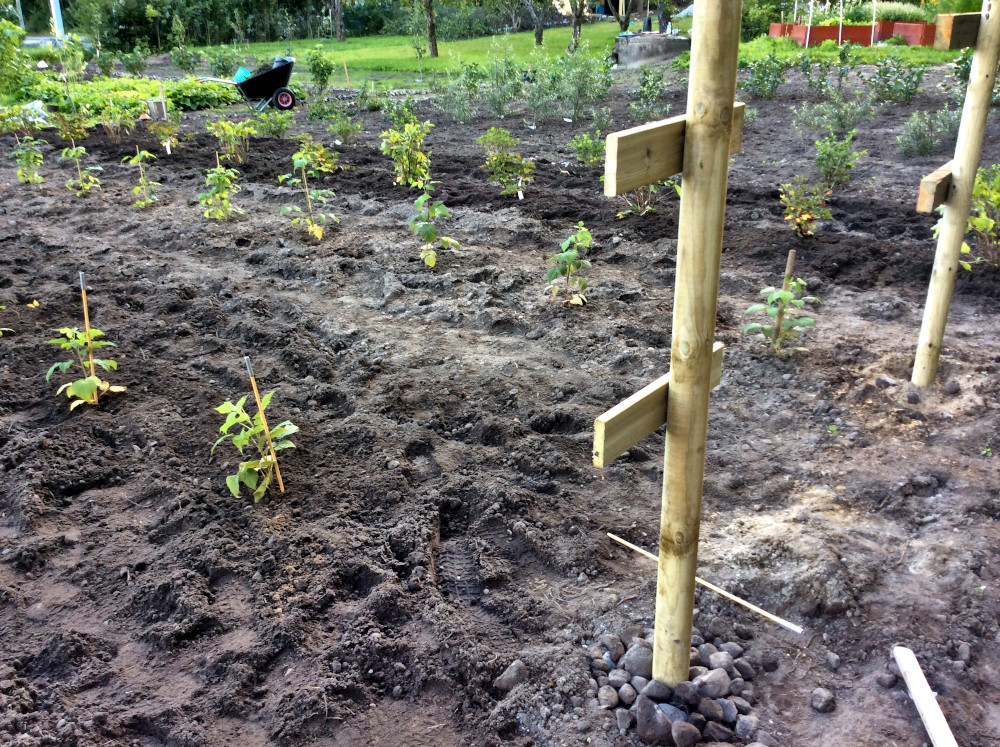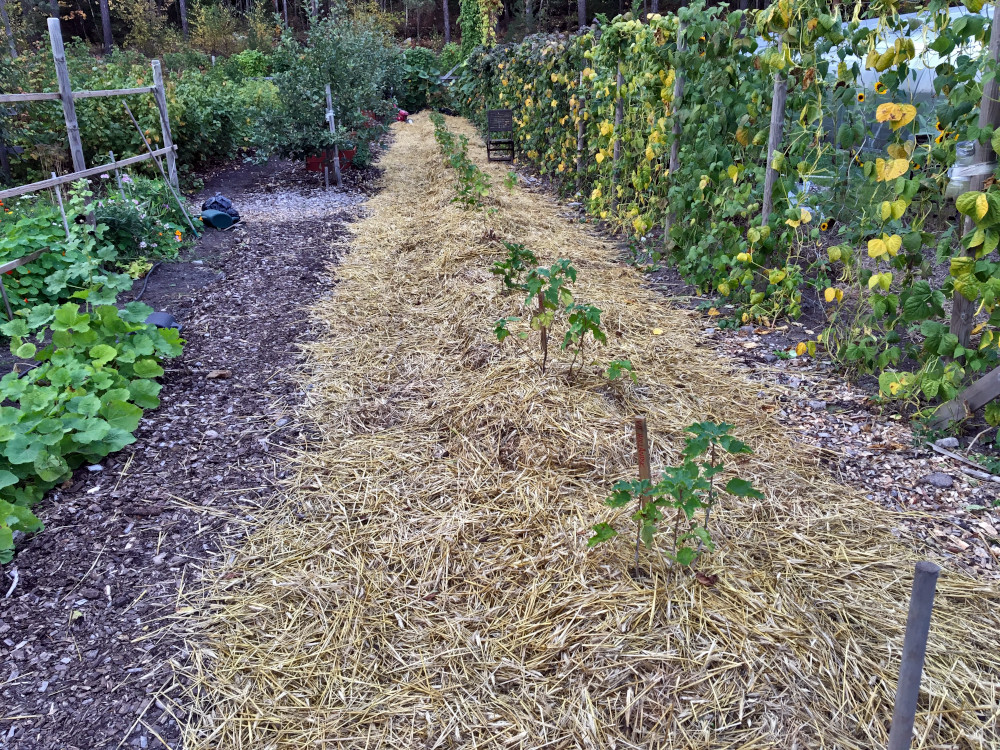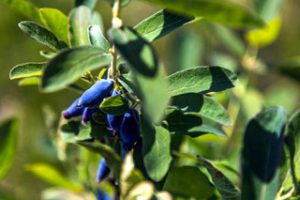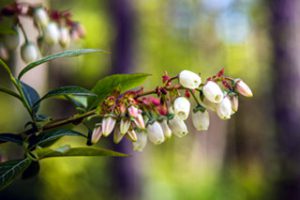Berries
GOOSEBERRY CATASTROPHES
Gooseberries are delicious. Childhood in Vallerinta, Paimio, was full of red and yellow ones which gave a good harvest every year. I just had to grow them in Tallbacka as well.
In 2016 we planted Lepaa’s red and Hinnonmäki’s yellow, six of each. They suffered because of drought, just like everything else the first year. There wasn’t enough water to water with and no material for mulching either to begin with. The tilling of the soil may have affected the soil’s microbes negatively and aggravated the situation even more. The harvest was pretty good in spite of the drought. The irrigation system which was installed last year (2020) will hopefully make things better in the future.
As we planned the new area’s plantings, I wanted more gooseberries. On Savonlinna Taimisto’s web pages I found some varieties with interesting names and decided I wanted to try them: Anna Viksne, Avenite and Kursun keltainen (Kursu’s yellow). When they were planted in summer 2018 we had the worst drought and the following year was just as bad. It turned out that the weakest variety was Kursun keltainen and the plants died. Sadly, the empty spaces were filled with Lepaa’s red and then came the catastrophe – gooseberry sawfly.
I worked intensively clearing the newest area for planting during the summer of 2020. Tired, I wasn’t observant enough when I walked past the gooseberry bushes. When I did notice the strangely bare branches it was already too late and the destruction too far gone. In no time at all the leaves had been eaten. A cry of help to the experts gave some hints: collect the caterpillars, soapy water, sulphur, spheciformes, cut back the bushes… confusing. We tried spraying with soapy water and this helped for a time, but they came back in waves again and again. The bushes managed to produce more leaves for the sawfly to eat. I cried when I saw those b***** sawflies’ collective power. Something had to be done but what?
I was wondering why some varieties had succumbed to sawfly. Had I made a bad choice to begin with? I realised that the long drought had made the plants susceptible to sawfly and that it wasn’t a question of varieties. Could the plants get better and survive? I don’t know the answer to that yet but I have decided to try again next summer. I’ll treat the soil with EM-solution and mulch more to try and strengthen growth. Then I’ll follow the sawflies annual cycle and pick caterpillars and spray at the right time. If the result looks like 2020’s, with a row of bare branches, then I’ll dig up all 46 bushes, cry a bit and then prepare new vegetable beds instead.
A LOCAL OF PARAINEN WHO LOVES RASPBERRY FLAVOURED WINE GUMS…

We planted 3 varieties of raspberry in our first year (2016) in rows: Yatsy, Muskoka and Ottawa as well as a yellow autumn raspberry Gold Fall. The supporting framework looked like the picture to begin with. The steel wire support worked really well but a second wire had to be fitted crosswise. Raspberry canes can be very tall and their thin spring growth can become dense in summer. We are are still learning about pruning and finding the optimal density.
They were our best berry that first summer. A reliable cropper, drought resistant and a fast grower.
A trip to Ostrobothnia and Blomqvist’s nursery (Blomqvists plantskola) in 2020 gave us an augmented selection of raspberry relatives. Black raspberry Rubus occidentalis “Bristol”, Salmonberry Rubus spectabilis “Olympic double”, European dewberry Rubus caesius, are newcomers to Finland. Strawberry raspberry or Balloon berry Rubus illecebrosus, tayberry and blackberry were supplemented with new plants. Wine raspberry Rubus phoenicolasius is growing for the third year running and has cropped.
CURRANTS
We started 2016 with 17 blackcurrant bushes, 6 redcurrant, 6 white currant and a dozen green currant. These are the varieties we chose: Öjebyn, Ben Tron, Punahilkka, Valkoinen Hollantilainen and Wilma. I love blackcurrants, the form of the bushes, the feel of the berry, the taste and of course, the wonderful aroma of blackcurrants. Green currants are a new acquaintance as they didn’t exist in my childhood. The taste is good, sweeter than the other currants and it’s said that the birds can’t see the berries, something not supported from our experience. But they are delicious. I don’t really care for redcurrants but the variety name Punahilkka (Red Riding Hood) was something from a fairy tale so I just had to have it. It crops well but the berries are quite small.
Later on we have planted other different varieties: Marski, Mikael and a berry which is praised by Savonlinnan taimisto Titania: (The top product of Finnish breeding. According to us the most popular and most grown variety at the moment in Europe and North America. Registered in Sweden in 1984 and is a cross between Altajskaja Dessertnaja x Consort x Kajaanin Musta. Originally the breeding has taken place in Finland. Titania produces large, quality berries with a fine sweet taste with all ripening almost at the same time and they do not fall off, split or tear easily. The berries are suitable for machine harvesting. The market values such a “box berry” and cropping/hectare is high. The bush is upright with very strong growth. Winter hardiness is good to very good, it is mildew resistant and immune to rust.
As a healthy and hardy variety it has the ability to crop well for a long time. Cropping levels in relation to area are enormous. U-pick farms have reported about 1½ buckets per bush. Great for machine harvesting. The only blackcurrant variety sold by us because no real rival to it has been found despite many attempts.)

Last summer, we dug up the strawberries as they had cropped enough and decided to plant white and green currants instead. Eight of each variety: Valkoinen Hollantilainen and Venny.
Aronia
Aronia or chokeberry – incredibly healthy, easy to grow but forgotten
The chokeberry has been a favourite of mine for a long time. I bought chokeberry bushes for the garden in Sagu because they are beautiful, quick growing and modest – the soil was an awful coarse clay. At first the berries tasted strange and woody but then when I dried and milled them and mixed them with sweet rowan-berry to create a top product for the morning yoghurt.
Even at Tallbacka they were among the first bushes to be planted, forty of the variety ‘Viking’ in two separate rows. 2021 was our sixth harvest, which was the best ever. Chokeberry is usually a safe bet and does not usually have bad years and is not plagued by bugs. Of course, cold periods in the spring and prolonged drought will affect the harvest.
Chokeberries have been used a long time in folk medicine. It raises resilience and helps during convalescence. The active substances are especially anthocyanin, flavonoids and polyphenols which are present in greater amounts in comparison to other berries. At Tallbacka we press the dark purple juice from fresh berries and freeze for later use. The remainder after pressing is dried and milled which removes the tannin taste that ‘sticks in the throat’ leaving only goodness.
Chokeberry is also a beautiful bush as you see in the picture with its glowing autumn colours.

Blue-berried honeysuckle
Lonicera caerulea var. Kamtschatica
Blue-berried honeysuckle has been used for centuries both as a medicinal plant and for berries in East Asia and Japan. It deserves, like no other, the epithet of super-berry. It is called the ‘berry of eternal youth’ on the Kamchatka Peninsula. It was in the 1950’s that Russia first started to develop tastier varieties and during the 1990’s it was Canada’s turn. Since the beginning of the new millennium it’s popularity has dramatically increased. In Finland there are now many commercial plantations.

The berries are sweet, aromatic and with just enough acidity. They are winter hardy, easy to look after and are not worried by sickness. The berries are easy to use and the amount of available varieties is large. It soon became clear that wanted to grow them too. We started with 3 different varieties, Vostorg, Silginka and Rebecka. We planted 48 bushes in the spring of 2018 which proved to be wrong as the summer drought was exceptional. We later increased numbers with some Canadian varieties, mostly to assist with pollination. There really are no ‘Russian’ or ‘Canadian’ varieties as they are crosses between many varieties. I believe and hope that the blue-berry honeysuckle bushes will get bigger and better as they have had a layer of compost and wood-chippings applied in the autumn of 2021.
The bushes fruit very early and there can be problems with pollination in cold springs as the pollinators are not active so early. The berries usually ripen a couple of weeks before the first strawberries. They are easy to pick as the bushes have no thorns.
Cornelian cherry
Cornus mas
In the Nordics, the dogwoods are known as decorative trees or bushes. The Cornelian cherry has a long history as a plant for nutritional purposes and medicinal use as well and as a useful wood. The new varieties ripen early and manage to do so even this far north as has been proved by Leif Blomqvist in Ostrobothnia (zone 4 in Finland) who has done groundbreaking work in making this plant known. Its biggest problem is its early flowering and at Tallbacka we have planted early flowering Pulmonaria (Lungwort) under the bushes to attract bumble bees. The bushes can give a huge harvest and become very old. The berries of Cornelian cherry are of average size, droplet shaped and sweet-sour. The first time I read about the berry it was a German author recommending Cornelian cherry ice cream. I was sold on the idea, I must have it.
Tallbackas bushes were purchased from Blomqvists plantskola in the autumn of 2020. Then he had four varieties so to celebrate my birthday we bought all four. The varieties were Nikolka, Jantamyj, Kovolowny Merte and Juliusz. I think that two were red, one yellow and for the last one I have no information. Polish is a difficult language!
They had a tough first winter, but also a covering of compost and wood-chippings autumn 2021 so now I hope that things are looking up for them.
Japanese silverberry
Elaeagnus umbellata
The silverberry is known as a hardy ornamental bush growing by the sides of roads. It is an unassuming plant but the berries are real health bombs. They are are easy to gather, in fact much easier than their relation the sea buckthorn. The variety umbellata does not make suckers. At Tallbacka the silverberry grows in a sunny position beside the garage in rather poor soil and together with thyme it survives almost anything. We harvested the first berries in 2021.
Jostaberry
Ribes nidigrolaria
The jostaberry is a cross between gooseberry, wild gooseberry and blackcurrant. This is astrong growing plant and the branches are almost completely devoid of thorns. The berries start out green but as they ripen they turn first red and finally black. They are larger than the blackcurrant but smaller than the gooseberry. It is said that the berries taste both of blackcurrant and gooseberry. The jostaberry is not fussy when it comes to soil and position.
Golden currant
Ribes aureum
It belongs to the currant family and the name refers to the fact that in spring the bushes are covered in with aromatic yellow flowers, in the summer with berries and a beautiful autumn colour. The bush is hardy and easy to look after. At Tallbacka we have the variety Black Pearl but the wonderfully orange Orangesse is on our must-have list.
Strawberry raspberry
Rubus illecebrosus
The strawberry raspberry is a bewildering acquaintance. It is a low bush that spreads with underground suckers like the raspberry. The berries are large and look like both raspberries or strawberries. The large flowers attract insects. The berries can be used on cakes as the taste is unassuming compared with its appearance.
Minikiwi
Actinidia kolomikta
New Zealand are famous for their Kiwi fruits (Actinidia deliciosa) but there are many varieties in the genus Actinidia. Actinidia kolomikta comes from southern Siberia and of course is winter hardy in Finland. It is said that they don’t loose in the taste test against the fruit in the shops which is absolutely right. The fruits are about two cm long. The vines are either male or female with the exception of the varieties Annikki and Dr Szymanowski, both self-fertile, and these were planted at Tallbacka together with the varieties Anna and Adam. We built a climbing frame for them near the house as they are climbing vines.
Saskatoon
Amelanchier alnifolia
Saskatoon has been an important berry for the native tribes in North America. Plant breeding was started at the beginning of the 20th century. The variety we have is Smoky and was among the first commercial successes. In Canada it is an important commercial product. Its success is explained due to its versatility and the fact that it is easy to grow and hardy. The berry can be compared to the blueberry when compared with its nutritional value. The taste is very sweet.
Blueberry
The wild bilberry is a favourite berry in the Finnish forest. This applies to the grandchildren as well if they pay a visit when they are ripe. No problems finding something to do.

Before we planted blueberry bushes we wondered if we should plant them at all. One of the reasons was that we had planted several different types of blueberry bushes in 2016 to see if they would thrive in the garden. Usually they require a very acidic soil which we don’t have and sure enough they didn’t do too well. This was the reason why we started a soil improvement project for them using rhododendron soil just above the vineyard. In 2018 we planted five rows of blueberries with the varieties Gold Traube and Blue Crop. The following year we planted another row with Blue North and Blue Country. One plant died and was replaced with Patriot. The first varieties we tried were Aino, Alvar, Arto and Chandler. This soil in this area needs to be improved and we are thinking of digging them up, improving the soil and then replanting.
The bushes don’t really thrive though, one reason being the summer drought that plagued the newly planted bushes. The irrigation system is also at work amongst the bushes and this did help the situation and growth. Last year was the first harvest, though not very much. The soil underneath the bushes is now covered with horse manure mixed with non-fertilised peat and wood-chippings. So the prerequisites are in place for new harvests and bigger, healthier bushes.